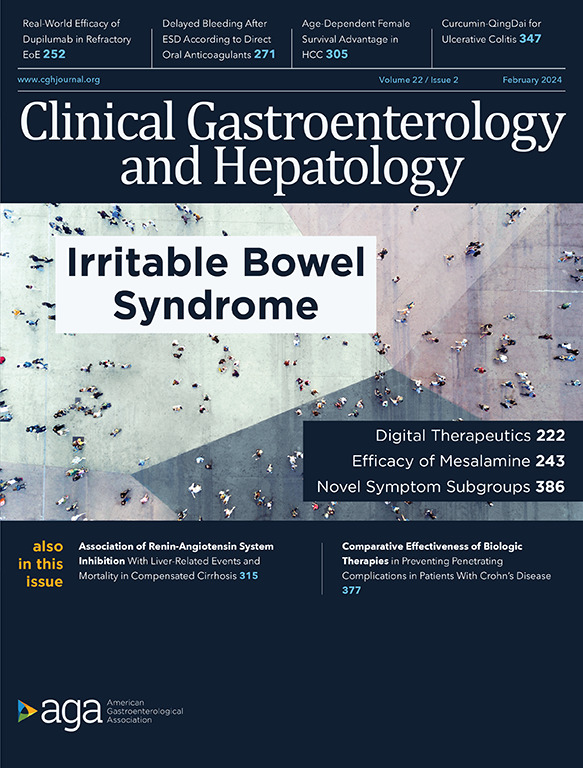The Association Between Obesity and Malignant Progression of Barrett’s Esophagus: A Systematic Review and Dose-Response Meta-Analysis
IF 11.6
1区 医学
Q1 GASTROENTEROLOGY & HEPATOLOGY
引用次数: 0
Abstract
Background and Aims
Obesity is a risk factor for both Barrett’s esophagus (BE) and esophageal adenocarcinoma (EAC). However, it is unclear whether obesity drives the malignant progression of BE. We aimed to assess whether obesity is associated with high-grade dysplasia (HGD) or cancer in patients with BE.
Methods
We searched MEDLINE and EMBASE from inception through April 2024 for studies reporting the effect of body mass index (BMI) on the progression of nondysplastic BE or low-grade dysplasia (LGD) to HGD or EAC. A 2-stage dose-response meta-analysis was performed to estimate the dose-response relationship between BMI with malignant progression. Study quality was appraised using a modified Newcastle-Ottawa scale.
Results
Twenty studies reported data on 38,565 patients (74.4% male) in total, of whom 1684 patients were diagnosed with HGD/cancer. Nineteen studies were considered moderate to high quality. Eight cohort studies reported data on 6647 male patients with baseline nondysplastic BE/LGD, of whom 555 progressed to HGD/EAC (pooled annual rate of progression, 0.02%; 95% confidence interval [CI], 0.01%–0.03%), and 1992 female patients with baseline nondysplastic BE/LGD, with 110 progressors (pooled annual rate of progression, 0.01%; 95% CI, 0.01%–0.02%). There was no significant difference in pooled annual rate of progression between males and females (P = .15). Each 5-kg/m2 increase in BMI was associated with a 6% increase in the risk of malignant progression (adjusted odds ratio, 1.06; 95% CI, 1.02–1.10; P < .001; I2 = 0%).
Conclusion
Our meta-analysis provides some evidence that obesity as measured by BMI is associated with malignant progression of BE with a dose-response relationship. This finding requires confirmation in future high-quality cohort studies. Future risk prediction models could incorporate measures of obesity to potentially improve risk stratification in patients with BE. PROSPERO, Number: CRD42017051046.
肥胖与巴雷特食管恶性进展之间的关系:系统综述和剂量反应荟萃分析。
背景和目的:肥胖是巴雷特食管(BE)和食管腺癌(EAC)的危险因素。然而,目前尚不清楚肥胖是否会导致BE恶性进展。我们旨在评估肥胖是否与 BE 患者的高级别发育不良(HGD)或癌症有关:方法:我们检索了从开始到 2024 年 4 月的 MEDLINE 和 EMBASE,以寻找报告体重指数 (BMI) 对非增生异常 BE 或低度增生异常 (LGD) 发展为 HGD 或 EAC 的影响的研究。研究人员进行了两阶段剂量反应荟萃分析,以估计BMI与恶性进展之间的剂量反应关系。研究质量采用修改后的纽卡斯尔-渥太华量表进行评估。综述已注册(PROSPERO ID CRD42017051046):20项研究共报告了38565名患者(74.4%为男性)的数据,其中1684名患者被诊断为HGD/癌症。19项研究被认为是中高质量的。八项队列研究报告了 6647 名基线 NDBE/LGD 男性患者的数据,其中 555 人进展为 HGD/EAC(汇总年进展率为 0.02%;95% CI 为 0.01%-0.03%);1992 名基线 NDBE/LGD 女性患者的数据,其中 110 人进展为 HGD/EAC(汇总年进展率为 0.01%;95% CI 为 0.01%-0.02%)。男性和女性的汇总年进展率没有明显差异(P=0.15)。BMI每增加5kg/m2,恶性进展的风险就会增加6%(调整后OR 1.06;95% CI 1.02-1.10;P2=0%):我们的荟萃分析提供了一些证据,表明以体重指数(BMI)衡量的肥胖与 BE 的恶性进展存在剂量反应关系。这一发现需要在未来的高质量队列研究中得到证实。未来的风险预测模型可纳入肥胖测量指标,以改善BE患者的风险分层。
本文章由计算机程序翻译,如有差异,请以英文原文为准。
求助全文
约1分钟内获得全文
求助全文
来源期刊
CiteScore
16.90
自引率
4.80%
发文量
903
审稿时长
22 days
期刊介绍:
Clinical Gastroenterology and Hepatology (CGH) is dedicated to offering readers a comprehensive exploration of themes in clinical gastroenterology and hepatology. Encompassing diagnostic, endoscopic, interventional, and therapeutic advances, the journal covers areas such as cancer, inflammatory diseases, functional gastrointestinal disorders, nutrition, absorption, and secretion.
As a peer-reviewed publication, CGH features original articles and scholarly reviews, ensuring immediate relevance to the practice of gastroenterology and hepatology. Beyond peer-reviewed content, the journal includes invited key reviews and articles on endoscopy/practice-based technology, health-care policy, and practice management. Multimedia elements, including images, video abstracts, and podcasts, enhance the reader's experience. CGH remains actively engaged with its audience through updates and commentary shared via platforms such as Facebook and Twitter.

 求助内容:
求助内容: 应助结果提醒方式:
应助结果提醒方式:


